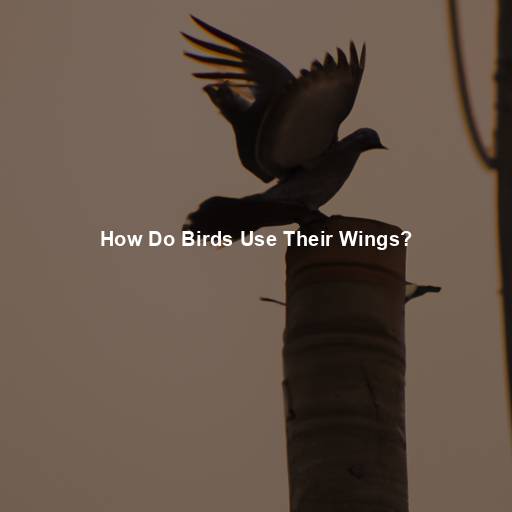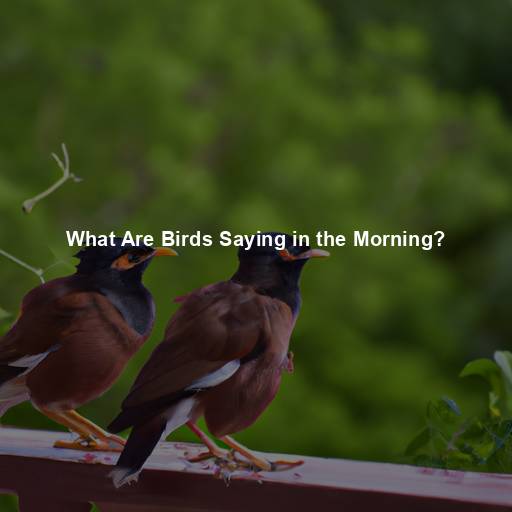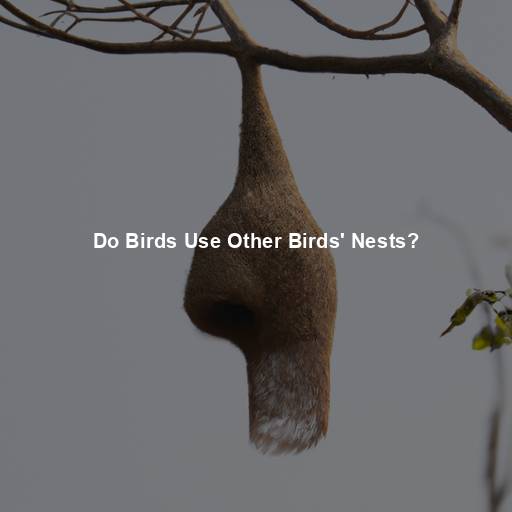How Do Birds Use Their Wings?
Last Updated on July 22, 2023 by Evan
Contents
- 1 Understanding the Mechanics of Avian Flight
- 1.1 The Anatomy of a Bird’s Wing
- 1.2 Lift and Thrust: The Key Forces Behind Avian Flight
- 1.3 Different Wing Shapes for Different Flight Styles
- 1.4 The Art of Wing Kinematics: Mastering Flapping
- 1.5 Flight Techniques: Gliding, Soaring, and Hovering
- 1.6 The Evolutionary Advantage of Flight
- 1.7 Feather Structure: A Perfect Balance of Strength and Flexibility
- 1.8 Feather Types and Their Functions
- 1.9 Wing Loading: A Measure of Flight Efficiency
- 1.10 The Science of Takeoff and Landing
- 1.11 Flight Adaptations in Different Bird Species
- 1.12 The Limitations of Avian Flight
- 1.13 Flightless Birds: The Exception to the Rule
- 1.14 Unraveling the Wonders of Avian Flight
- 1.15 In Awe of Avian Mastery
- 2 FAQs – How do birds use their wings?
Understanding the Mechanics of Avian Flight
Birds, those enchanting creatures renowned for their celestial elegance and boundless freedom, have captivated our curious minds throughout history. Their ethereal mastery of the heavens, traversing vast expanses with instinctual precision and executing daredevil mid-air acrobatics, leaves us in perpetual wonderment. But amidst this breathtaking spectacle, one question persists: How do these miraculous beings harness the power of their wings to achieve such unrivaled grandeur? In this captivating exploration, let us embark on a journey into the intricate mechanics of avian flight, unraveling the enigmatic secrets that lie beneath their majestic aerial prowess.
The Anatomy of a Bird’s Wing
To comprehend how birds utilize their wings, we must first understand their anatomy. A bird’s wing is a complex structure designed for optimal flight performance. It consists of several key components, including the primary feathers, secondary feathers, and the alula.
-
Primary Feathers: These are the longest and most important feathers located at the tip of the wing. They generate most of the lift during flight.
-
Secondary Feathers: Found closer to the bird’s body, secondary feathers aid in lift production and contribute to maneuverability.
Discover the marvels of aviation with the alula! This remarkable feature, nestled at the forefront of the wing, possesses the power to manipulate airflow, engaging its prowess during critical moments such as takeoff and landing. Delve into the intricate mechanics of this enigmatic device, unlocking its secrets and marveling at its ability to control the very essence of flight. Buckle up and prepare to be captivated by the alula’s burst of brilliance!
Lift and Thrust: The Key Forces Behind Avian Flight
In the vast expanse of the sky, birds wield the enigmatic powers of lift and thrust to conquer the boundless realm of flight. Like a mystical dance with gravity, lift emerges as an ethereal force that defies Earth’s gravitational pull, casting birds into the mesmerizing abyss of the heavens above. On the wings of thrust, these avian marvels exude a captivating energy, propelling themselves with an elegant vigor through the very fabric of the air itself. Together, these enigmatic forces intertwine, unveiling the beguiling secrets of avian flight.
Lift: Harnessing the Power of Air
Have you ever wondered how birds are able to soar effortlessly through the sky? It’s all about the magic of lift. As these majestic creatures flap their wings, a fascinating interplay of air pressures takes place. The unique shape of their wings, with a curved upper surface and flatter lower surface, sets the stage for an extraordinary phenomenon.
Thrust: Propelling Forward Motion
In the mesmerizing world of avian locomotion, the elusive force of thrust emerges as the enigmatic hero that propels our feathered friends forward amidst the resistance of the boundless sky. Through an intricate dance of wing flapping and shape manipulation, birds orchestrate their aerial symphony, defying the laws of gravity with finesse. As their wings unfurl and flutter, a hidden pattern emerges, unveiling the secret to their forward propulsion. Meanwhile, the shape-shifting wonders unfold as the birds morph their wings, skillfully adjusting the angles and curvatures to unlock the full potential of thrust generation.
Different Wing Shapes for Different Flight Styles
Birds are like a vibrant parade of diverse species, each flaunting its own distinct personality. And just like their personalities, their wings are an intricate canvas of whimsical shapes and structures. From graceful curves to intricate patterns, these wings are customized to cater to their individual flight styles and preferred habitats. So next time you spot a bird soaring through the sky, take a moment to appreciate the burst of creativity that nature has bestowed upon their magnificent wings.
Elliptical Wings: Perfect for Agility
The tiniest creatures of the sky, like charming sparrows and nimble robins, possess an extraordinary knack for navigating their way through the world. Their wings, oh so distinctive, take the shape of elegant elliptical curves. Unassuming in size and gracefully rounded, these wings bless them with the ability to swiftly alter their course, making sharp turns seem like child’s play. Encased in this elliptical marvel, these avian wonders gracefully glide through dense foliage and conquer the most intricate of nooks and crannies.
High-Aspect Ratio Wings: Masters of Soaring
Species like eagles, hawks, and albatrosses possess high-aspect ratio wings. These wings are long and narrow, enabling birds to soar for extended periods. The elongated shape reduces drag and enhances lift, allowing these birds to glide effortlessly on thermals and currents of air.
Swept-Back Wings: Conquerors of Speed
When it comes to soaring through the skies, certain birds have truly cracked the code. Take falcons and swifts, for example, with their remarkably streamlined wings that seem to defy gravity. These avian aerialists have a secret weapon: the mesmerizing sweep of their wings, curving backwards like a wisp of imagination. This unique design not only minimizes resistance but propels them to unparalleled speeds, pushing the boundaries of what we thought was possible in avian aviation.
The Art of Wing Kinematics: Mastering Flapping
Flapping is a fundamental aspect of avian flight, and birds employ various wing kinematics to adapt to different flight requirements. Wingbeat frequency, wing amplitude, and wing shape manipulation all play a crucial role in determining a bird’s flight capabilities.
Wingbeat Frequency: The Rhythm of Flight
Have you ever wondered how birds effortlessly navigate the skies? It turns out that these incredible creatures have a secret – they can adapt their wingbeat frequency to suit different flight modes. When it comes to takeoff and landing, where precision is paramount, birds kick it up a notch, flapping their wings at astonishing speeds. However, when it’s time for some leisurely gliding or soaring, they take it easy, reducing their wingbeat frequency to conserve energy.
Wing Amplitude: Adjusting Lift and Thrust
The awe-inspiring world of avian aerodynamics never ceases to amaze. Birds possess an extraordinary knack for dynamically fine-tuning their wing movements, effortlessly navigating the vast tapestry of the sky. With seemingly magical prowess, they seamlessly adjust the amplitude of their wing flaps, defying gravity as they effortlessly ascend to greater heights or gracefully descend in a mesmerizing ballet of flight. Their ability to control lift and thrust through such intricate wing adjustments is a testament to their unfathomable adaptability and inherent mastery of the skies.
Wing Shape Manipulation: Adapting to Flight Conditions
Birds can manipulate the shape of their wings during flight to optimize performance. By adjusting the angle of attack, a bird can fine-tune lift and thrust generation. Additionally, birds alter the curvature of their wings to adapt to changes in airspeed and flight conditions.
Flight Techniques: Gliding, Soaring, and Hovering
Birds have evolved various flight techniques, each serving a specific purpose. From graceful gliding to soaring on thermals and even hovering in mid-air, these techniques showcase the incredible adaptability and versatility of avian flight.
Gliding: Harnessing Air Currents
Have you ever marveled at the effortless flight of birds, as they effortlessly soar through the sky? It’s a mesmerizing sight, filled with grace and wonder. But have you ever wondered how they manage to cover such vast distances without tiring themselves out? Enter the world of gliding, a fascinating flight technique employed by birds to navigate the skies while conserving their precious energy.
Soaring: Riding the Thermals
Discover the awe-inspiring world of soaring, where birds defy gravity and effortlessly conquer the sky. With their remarkable ability to ride the unpredictable currents of warm air, these avian acrobats, including majestic hawks and impressive buzzards, elevate gliding to new heights. By skillfully maneuvering within the invisible boundaries of thermals, these phenomenal creatures ascend with minimal exertion, giving them the freedom to navigate expansive territories in their relentless quest for sustenance or during their epic migrations. Embrace the wonder of soaring as we unravel the secrets of these mysterious aerial artists.
Hovering: Defying Gravity
Witnessing the awe-inspiring aerial acrobatics of certain avian wonders, such as the nimble hummingbirds and majestic kestrels, truly leaves one in a state of bewildered admiration. Behold the extraordinary skill exhibited by these feathered beings as they effortlessly suspend themselves in the ethereal realm. Such defiance of the very laws of gravity is made feasible through their extraordinary wing flapping prowess and unmatched wing control, enabling them to access precious nectar hidden within the hearts of flowers or display unrivaled predatory precision in their hunting endeavors. Truly, hovering emerges as a captivating phenomenon that leaves us spellbound, marveling at the perplexing wonders of nature.
The Evolutionary Advantage of Flight
The majestic ability of flight has bestowed birds with a myriad of advantages, unveiling a world of untapped possibilities. From unlocking elusive food sources to evading the clutches of predators, and embarking on epic journeys across vast distances for the sake of breeding or adapting to the seasons – flight has intricately woven itself into the very fabric of avian existence. This unparalleled gift has served as a catalyst for the evocative evolution and captivating diversification of these majestic creatures, leaving us utterly mesmerized and perpetually perplexed.
Feather Structure: A Perfect Balance of Strength and Flexibility
Feathers are composed of a central shaft called the rachis, which provides structural support. Extending from the rachis are barbs, which are further divided into barbules. Barbules have tiny hooks that interlock, creating a cohesive and aerodynamic surface. This interlocking mechanism ensures that the feathers remain intact during flight, maintaining the integrity of the wing shape.
Feather Types and Their Functions
Birds have an astonishing array of feathers, each performing its own extraordinary role as they take to the skies. These splendid creatures rely on a diverse assortment of feather types, each meticulously crafted for a precise purpose during flight. From streamlined flight feathers that offer impeccable aerodynamics to downy feathers that provide essential insulation, the intricate design and functionality of avian plumage never ceases to amaze. Join us on a captivating journey into the realm of feathers, where the mysteries of flight unravel in a breathtaking display of nature’s ingenuity.
Discover the astounding world of contour feathers, nature’s architectural marvels, that empower birds to soar through the skies with remarkable grace. Serving as the ultimate fashion statement, these exquisite plumes effortlessly mold birds’ figures, minimize air resistance, and act as nature’s very own wings, enabling their awe-inspiring flight. Prepare to be captivated as we unravel the secrets behind these magnificent feathers, unveiling their crucial role in shaping avian beauty and allowing our feathered friends to conquer the heavens.
Flight feathers are the unsung heroes of avian aerodynamics, tucked elegantly on the wings and tail. These remarkable plumes possess an enigmatic quality, for they hold the key to avian locomotion. Crafted longer and stiffer than their contour counterparts, flight feathers empower birds to conquer the skies with their unrivaled mastery of lift and thrust, granting them a captivating spectacle of in-flight maneuverability.
Feathers, those whimsical wonders of nature, harbor an enchanting secret: down feathers. These ethereal beauties, meticulously designed by evolution, play a crucial role in the avian realm. Though not integral to flight itself, their fluffy embrace acts as an insulating shield, enveloping birds in a cozy cocoon amidst the elements. Furthermore, these enigmatic down feathers weave their magic by skillfully filling in any gaps between their more prominent counterparts, the flight feathers, diminishing unruly turbulence and ensuring smooth sailing through the skies.
Wing Loading: A Measure of Flight Efficiency
Have you ever wondered how birds effortlessly soar through the sky, defying gravity with their graceful movements? Well, one of the secrets lies in a concept called wing loading. Wing loading is the magical ratio that brings together a bird’s body weight and its wing area, ultimately determining its flight efficiency and maneuverability. It’s fascinating to discover that birds with lower wing loading, thanks to their lighter weight and larger wing area, are masters of slow-flight and can effortlessly execute breathtaking aerial acrobatics.
The Science of Takeoff and Landing
Takeoff and landing are critical phases of flight that require precise wing movements and coordination. Let’s explore the mechanics behind these maneuvers.
Takeoff: Defying Gravity
Birds are truly marvels of nature when it comes to taking flight. Their takeoff process is nothing short of extraordinary, as they navigate through the pressures of defying gravity. To overcome this challenge, our feathered friends employ a remarkable combination of wing flapping and leg power. By flapping their wings with remarkable speed, they generate an impressive amount of lift, while simultaneously leveraging the power of their legs to push against the ground, propelling themselves gracefully into the sky.
Landing: A Controlled Descent
Landing requires careful control and coordination to ensure a safe descent. As birds approach the landing site, they adjust their wing positions and angle of attack to reduce speed and altitude gradually. Once close to the ground, they extend their legs and use them as landing gears, absorbing the impact and providing stability.
Flight Adaptations in Different Bird Species
Birds have adapted their flight techniques to suit their specific ecological niches. Let’s explore some remarkable flight adaptations observed in various bird species.
Hovering: The Hummingbird’s Aerial Ballet
The world of hummingbirds is a realm of captivating wonder. These magical creatures possess an awe-inspiring ability to hover gracefully in the air, their wings fluttering at an astonishing speed. It is through this unparalleled mastery of flight that hummingbirds unlock the gateway to sweet nectar, accessing a world of sustenance that remains elusive to their avian counterparts. Their remarkable adaptation is a testament to the sheer beauty and complexity of the natural world.
Soaring: The Albatross’s Endurance Flight
When it comes to defying gravity, albatrosses certainly know how to make jaws drop. These majestic creatures have a mind-boggling ability to glide through the air for what seems like an eternity, sans any wing flapping. How do they do it, you ask? Well, through a mind-bending technique called dynamic soaring, these avian marvels tap into the wind’s powerful embrace as they gracefully navigate the skies in an intricate figure-eight dance.
Diving: The Peregrine Falcon’s Speed Demon
There is a bird in the avian kingdom that defies all expectations with its breathtaking speed. Known for its lightning-fast hunting dives, the peregrine falcon has been deemed the undisputed speed champion of the bird world. With an ability to soar at mind-boggling speeds of over 240 miles per hour, this magnificent creature leaves even the most seasoned bird enthusiasts in a state of awe and perplexity. How does it achieve such astonishing velocities?
The Limitations of Avian Flight
It’s no secret that birds have an extraordinary knack for soaring through the skies with grace and finesse. However, their aerial prowess does come with its fair share of limitations, thanks to the intricacies of their anatomy and unique physiological makeup. These constraints, though perplexing at times, have only served to add an extra layer of complexity to the bird’s remarkable abilities. From their wing structure to their respiratory system, every aspect of a bird’s biology contributes to the intricate dance between freedom and confinement that defines their flight.
Size and Weight Restrictions
Large birds, such as ostriches and emus, have reduced flight capabilities due to their size and weight. Their wingspan is not sufficient to generate enough lift to support their massive bodies. As a result, these birds have adapted to a terrestrial lifestyle.
Environmental Factors
Birds’ flight is also influenced by environmental factors such as wind speed, air density, and temperature. These factors can affect a bird’s ability to generate lift, alter its flight performance, and impact navigation during long-distance migrations.
Flightless Birds: The Exception to the Rule
While most birds are proficient flyers, there are exceptions in the form of flightless birds. These birds, such as penguins and ostriches, have evolved to live in environments where flight is unnecessary or impractical. Instead, they have adapted for efficient movement on land or in water.
Unraveling the Wonders of Avian Flight
Birds in flight have always been a source of wonder and intrigue for both people who dedicate their lives to uncovering nature’s secrets and those who simply appreciate the beauty of these graceful creatures. By meticulously observing their soaring maneuvers, conducting cutting-edge research, and harnessing the power of technology, we continuously unravel the enigma of avian flight. This journey not only reveals the remarkable adaptations that have evolved over millennia, but also ignites our imagination, fueling innovation in aviation and engineering. In this boundless realm of exploration, every feathered inch is a treasure trove of possibilities, leaving us both captivated and inspired.
In Awe of Avian Mastery
The awe-inspiring ability of birds to take flight is a striking reminder of the brilliance of the natural world. Their wings, crafted with remarkable precision, allow them to navigate the vast expanse of the skies with astonishing dexterity. As we delve deeper into the mysteries of avian flight, we cannot help but be captivated by the intricate techniques these airborne marvels employ, reminding us of the intricate threads that connect us all within the mesmerizing fabric of nature. Let us embrace this wondrous connection and find solace in the enthralling dance shared between birds and humankind amidst the bewildering complexity of our natural realm.
FAQs – How do birds use their wings?
What is the purpose of a bird’s wings?
When it comes to soaring through the skies, birds have got it all figured out. With their magnificent wings, these master aviators effortlessly defy gravity and glide with grace. But it’s not just about flying – their wings are essential for a multitude of purposes. From sending messages to potential mates, to flaunting their prowess during courtship rituals, and even fiercely defending their turf, wings are the ultimate multitasking tools in the feathery world. So, the next time you spot a bird in flight, marvel at the burst of energy and perplexing maneuvers that bring these enchanting creatures to life.
How do birds generate lift with their wings?
Birds generate lift by producing an upward force that counters the force of gravity. When a bird flaps its wings, the shape and angle of the wings create a difference in air pressure between the upper and lower surfaces. This pressure difference creates an aerodynamic force called lift, which enables birds to overcome gravity and stay airborne. By adjusting the shape and angle of their wings during flight, birds can optimize lift production and control their altitude and speed.
What other functions do bird wings serve apart from flight?
Bird wings, much more than mere tools for flying, possess a myriad of functions that enchant and perplex us. As these feathery extensions spread wide, they gracefully maintain balance and stability, whether perching delicately on a branch or stepping with purpose on solid ground. It is awe-inspiring to witness how wings effortlessly transform into instruments of survival, aiding in the chase and capture of prey, enabling birds to hover in the air while searching for sustenance. And yet, we cannot overlook the captivating dances performed by birds like the peacock, where wings become vibrant canvases, displaying an iridescent palette that resonates deeply with the artistry of courtship. Finally, wings serve as a formidable shield, unfurling like a majestic battle standard, signaling territorial boundaries and warding off potential adversaries. These enigmatic appendages truly embody the astonishing diversity and complexity of avian existence.
Are all bird wings the same?
No, bird wings can vary significantly in size, shape, and specialized adaptations depending on the species and its ecological niche. For example, birds that are adapted for soaring or long-distance migration usually have long, broad wings that provide maximum lift and efficient gliding. On the other hand, smaller birds or those requiring high maneuverability, such as hummingbirds or birds of prey, possess shorter and more pointed wings. These variations in wing structure enable different species to excel in various flight behaviors or habitats.
Can birds fly without wings?
It’s a fascinating thought, isn’t it? Imagining birds taking to the skies without wings seems to defy the laws of nature. Wings are the quintessential tools that birds have evolved to soar the vast expanse of the sky. Their intricate wing structure, delicate yet resilient, enables them to ride the currents and embark on breathtaking flights. Without wings, birds would be grounded, their ability to navigate the skies and explore the world in which they belong restricted, leaving us in a state of awe and disbelief at the sheer wonder of flight.







